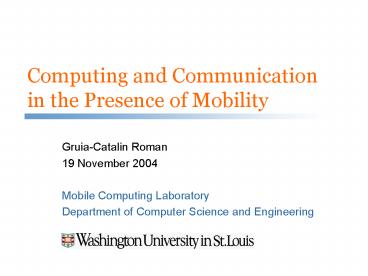Computing and Communication in the Presence of Mobility - PowerPoint PPT Presentation
1 / 27
Title:
Computing and Communication in the Presence of Mobility
Description:
Ford, Monsanto, Boeing, Emerson. 24. Collaborative Project Dimensions ... fusion of ideas from different operational environments ... – PowerPoint PPT presentation
Number of Views:31
Avg rating:3.0/5.0
Title: Computing and Communication in the Presence of Mobility
1
Computing and Communicationin the Presence of
Mobility
- Gruia-Catalin Roman
- 19 November 2004
- Mobile Computing Laboratory
- Department of Computer Science and Engineering
2
Project Team
- Faculty
- Gruia-Catalin Roman
- Doctoral Students
- Chien-Liang Fok
- Radu Handorean
- Jamie Payton
- Rohan Sen
- Octav Chipara (NSF - ITR)
- Gregory Hackmann (WU)
- Doctoral graduates
- Christine Julien (UT Austin2004)
- Qingfeng Huang (PARC2003)
3
Project Visibility
- Paper publication statistics (since 2002)
- published 24
- in press 9
- under review 14
- Keynote talks invited papers
- ASM 2003
- FASE 2004
- SELMAS 2004
- PRISE 2004
- Professional leadership
- ICSE 2005General Chair
- ACM TOSEMAssociate Editor
4
Research Themes
- MURI Project Themes
- Interoperability
- Context-awareness
- Formal models
- Middleware
- WUSTL Distinct Perspective
- Rapid development of dependable applications in
the presence of mobility
5
CONTESSA Technologies
6
Problem Formulation
- Building software for a brave new world
- mobility of environmental entities
- physical mobility of hosts
- logical mobility of code
- open environment operation
- spatiotemporal constraints
- expectation gap
- highly individualized
- resource sensitive
- task-centered
7
Solution Path
- Clean conceptual models
- context awareness
- spatiotemporal dimension
- Formalization and analysis
- understanding fundamentals
- supporting analysis
- Middleware encapsulation
- interoperable
- adaptive
8
Foundations for Mobile Computing
- Formal Models
- Mobile Unity
- coordination middleware semantics
- coordination schemas
- Context Unity
- Algorithms
- network abstraction
- disconnected message delivery
- Protocols
- mobicast
- spatiotemporal communication
9
Middleware for Mobility
- Egocentric Context-Aware Computing (EgoSpaces)
- asymmetric coordination constructs
- transparent context maintenance
- simplification of application development
- Service Provision in Ad Hoc Networks (Lime
Limone) - automated code management
- knowledge-driven interactions
- follow-me sessions
- Mobile Agents in Sensor Networks (Agilla)
- flexible in-network reprogramming
- autonomous processing
- intelligent emergent behavior
10
Middleware for MobilityEgocentric Context-Aware
Computing
- EgoSpaces agent-tailored multiple views
- declaratively specified views
- transparent context maintenance
11
Foundations for Mobile Computing Network
Abstraction
- Context maintenance protocol
- agent-controlled scope
- distributed
- adaptive
12
Middleware for Mobility Service Provision in Ad
Hoc Networks
- Limone coordination engine
- consistent distributed service registries
- flexible code distribution
- adaptive, secure and continuous service
application
application
service provision
service provision
secure tuples secure tuple spaces
secure tuples secure tuple spaces
Limone
security table
Limone
security table
remote interactions
interceptor
interceptor
13
Foundations for Mobile Computing Service
Provision Dynamics
Server Migration
Pull Server
Use Service
Push Server
Transfer state
Task Finished
14
Middleware for Mobility Spatiotemporal
Communication
- Mobicast a novel multicast paradigm
- energy efficient protocol
- novel analysis of network geometry
clear the road!
15
Foundations for Mobile Computing Reliable
Mobicast Delivery
16
Middleware for Mobility Mobile Agents in Sensor
Networks
- Agilla agile agent middleware
- sensor networks as a shared computing resource
2
1
3
4
17
Agilla System Architecture
Node (2,1)
Node (1,1)
Agents
Agents
migrate
remote access
Tuplespace
Tuplespace
Agilla Middleware
Agilla Middleware
TinyOS
TinyOS
MICA2 Mote
MICA2 Mote
18
Agilla Agent Architecture
19
Agilla Programming Style
20
Agilla Location-Based Addressing
(3,3)
(3,1)
(3,2)
(2,2)
clone(3,3)
clone(3,1)
Fire Detection Agent
(1,3)
(1,1)
21
Agilla Engineering Challenges
- Unreliable, low-bandwidth communication
- divide agent into small (lt 41 bytes) packets
- use acknowledgements, timeouts, and retransmits
- perform hop-by-hop migration
clone(4,1)
(1,1)
(2,1)
(3,1)
(4,1)
22
Agilla Performance Evaluation
Local Operations
Remote Operations
23
Agilla Technical Contributions
- New paradigm for programming sensor networks
- flexible coordination
- fluid, adaptive, and open software structure
- reduced development time
- reasonable performance
- Technology transfer implications
- demonstrated feasibility
- defined a research agenda
- initiated discussions with Ford, Monsanto,
Boeing, Emerson
24
Collaborative Project Dimensions
- Multi-faceted systems collaboration with UCI
- Agent Systems for Sensor Networks
- development of several applications
- deployment on a 90-mote sensor network in the
Mobilab - Mobile Interoperating Systems
- adaptable applications for grid and ad hoc
networks - intelligent evolution between modes
- deployed on 2 Dell Axims and 1 Sharp Zaurus
- Crosscutting concerns with UIUC
- Semantics of coordination
- Energy efficient protocols
- Secure communication
- Probabilistic analysis
25
Grand Challenge Problems
- Escaping the towering inferno
- opportunistic code and data exploitation
- Crossing the rapids
- sensor augmented navigation
- Working on a wrist watch
- opportunistically formed distributed applications
- Conducting stealth operations
- software fluidity supporting cooperative behavior
26
Ongoing and Future Research
- Context-awareness
- Predictable software development processes for
applications over dynamic ad hoc networks - Service provision
- Long-lived and adaptable applications serving
resource-poor mobile devices in resource-rich
environments - Agent-based applications
- Analyzable, predictable, secure, adaptive, and
survivable exploitation of sensor networks
27
Conclusions
- Distinct perspective on mobility
- formal models, algorithms, protocols
- middleware implementations for ad hoc networks
- evaluation through applications
- Collaborative efforts
- design of agile and adaptive systems
- fusion of ideas from different operational
environments - demonstration and evaluation through
implementation































